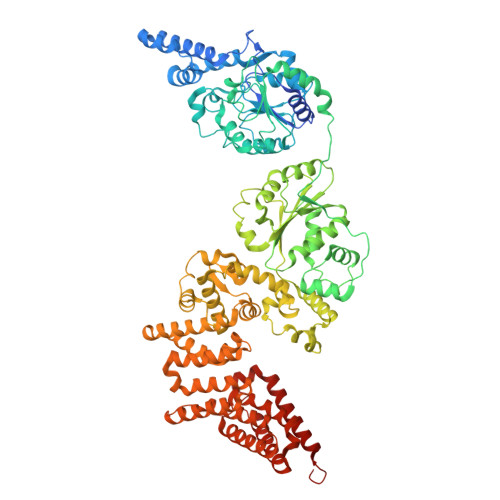Filamentation activates bacterial Avs5 antiviral protein.
Wang, Y., Tian, Y., Yang, X., Yu, F., Zheng, J.(2025) Nat Commun 16: 2408-2408
- PubMed: 40069208
- DOI: https://doi.org/10.1038/s41467-025-57732-7
- Primary Citation of Related Structures:
9JAP - PubMed Abstract:
Bacterial antiviral STANDs (Avs) are evolutionarily related to the nucleotide-binding oligomerization domain (NOD)-like receptors widely distributed in immune systems across animals and plants. EfAvs5, a type 5 Avs from Escherichia fergusonii, contains an N-terminal SIR2 effector domain, a NOD, and a C-terminal sensor domain, conferring protection against diverse phage invasions. Despite the established roles of SIR2 and STAND in prokaryotic and eukaryotic immunity, the mechanism underlying their collaboration remains unclear. Here we present cryo-EM structures of EfAvs5 filaments, elucidating the mechanisms of dimerization, filamentation, filament bundling, ATP binding, and NAD + hydrolysis, all of which are crucial for anti-phage defense. The SIR2 and NOD domains engage in intra- and inter-dimer interaction to form an individual filament, while the outward C-terminal sensor domains contribute to bundle formation. Filamentation potentially stabilizes the dimeric SIR2 configuration, thereby activating the NADase activity of EfAvs5. Furthermore, we identify the nucleotide kinase gp1.7 of phage T7 as an activator of EfAvs5, demonstrating its ability to induce filamentation and NADase activity. Together, we uncover the filament assembly of Avs5 as a unique mechanism to switch enzyme activities and perform anti-phage defenses.
- State Key Laboratory of Microbial Metabolism, School of Life Sciences and Biotechnology, Shanghai Jiao Tong University, Shanghai, China.
Organizational Affiliation:


















